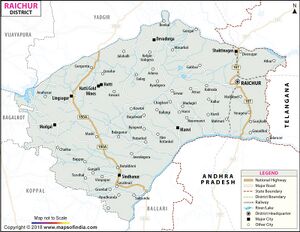Mudgal
| Author:Laxman Burdak, IFS (R) |

Mudgal (मुद्गल) is a villagen in Lingsugur taluk, Raichur district in the Indian state of Karnataka. Mudgal is about 10 miles south-west of Lingsugur.
Variants
- Mudgala मुद्गल, जिला रायचूर, कर्नाटक, (AS, p.751)
- Mudugal
- Madaggal
- Al-Madaggal
Mention by Panini
Mudgala (मुद्गल) is mentioned by Panini [1]
In Mahabharata
Mudgala (मुद्गल)
Sandhya Jain[2] mentions Mudgala (मुदगल) as Mahabharata Tribe with unclear position in Kurukshetra War - Defeated by Krishna (VII.11.39).
History
Mudgal has several inscriptions belonging to the Seuna Yadavas of Devagiri. It is known for its historical heritage and communal harmony. The main attractions here are the remnants of the Mudgal fort and an ancient Roman Catholic church built by the Jesuits before 1557.
There are ancient temples of Aswathhanarayana, Venkatesha, Narasimha and Didderayah.
Mudgal's existence dates back to Neolithic era.[3] Mudgal is also known as Lord Ganesha's teacher. Mudgal is one of the most important places of historical interest in Raichur District, next in importance only to Raichur. Mudgal or Mudugal has a history dating back to the Seuna Yadavas of Devagiri, several inscriptions of which have been discovered in and around the town. In 11th century Mudgal was an educational centre for the students of various parts of the country. In the beginning of the 14th century, it was an important outpost of the Kakatiya kingdom. Ala-ud-din Bahman Shah, after seizing Devagiri, captured Mudgal along with Raichur.
Some recent controversy regarding the original name of Mudgal had arisen by many Historians claiming that it was actually called "Al-Madaggal" during the Bahmani Sultanate era meaning "Place which has been agriculturally cultivated" in Arabic since the Bahmani Turks were predominantly Turko-Arab. After the establishment of the Bahamani Dynasty, the Bijapur kings took possession of the western and southern parts of the territory of the Bahmani kingdom including the forts of Raichur and Mudgal. During 16th century Mudgal was ruled by Vijayanagar Empire. Many battles were fought between Vijayanagar emperors and Bahamani sultans.
Vijayanagar empire's Krishna devaraya after undertaking Raichur then he went across Mudgal to Bijapur in his campaign
The Mudgal fort was the seat of the Yadava governors of Deogiri in 1250. It came successively into the possession of the rajas of Warangal, the Bahmani and Bijapur Sultans, and lastly it fell to Aurangzeb. There is a small Roman Catholic colony in the town, whose ancestors were originally converted by one of St Xavier’s missionaries from Goa. The church was built at an early date and contains a picture of the Madonna.[4]
Jat History
Ram Swarup Joon[5] writes that about Dharan or Dhariwal : One branch of the Mudgals was called Dharan. At present there are Dharan Jats as well as Brahmins. Later on, These people become known as Dhariwals. The daughter of Chandra Gupta II who was married to King Rudra Sen has given her gotra as Dharan. Sardar Jai Singh Dhariwal was included in twelve misls of the Sikhs.
Hukum Singh Panwar (Pauria) [6] mentions that Uttara Panchala king Mudgala Bharmyashva (भार्म्यश्व) was a well-known kingly (Kshatriya) composer of Nabhanedhishth.
मुद्गल
विजयेन्द्र कुमार माथुर[7] ने लेख किया है ... मुद्गल (AS, p.751) जिला रायचूर, कर्नाटक में स्थित है. 1250 ई. में देवगिरी के प्रसिद्ध यादव नरेशों का मुख्य नगर था. कालक्रम में वारंगल, बहमनी राज्य और बीजापुर रियासत के मुगल साम्राज्य में मिलाए जाने पर मुद्गल भी इसी साम्राज्य में विलीन हो गया. रोमन कैथोलिकों का एक उपनिवेश मुद्गल में स्थित है जो गोवा से सेंटजेवियर के भेजे हुए प्रचारक द्वारा ईसाई बना लिए गए थे. यहां का गिर्जा काफी प्राचीन है और उसमें मैडोना का एक प्राचीन चित्र है. दक्षिण भारत की एक प्रख्यात प्रेमगाथा की नायिका पारथल (Parthal) की जन्मभूमि मुद्गल ही कही जाती है. सुंदरी पारथल मुदगल के एक स्वर्णकार की पुत्री थी.
मुदगल परिचय
मुदगल कृष्णा और तुंगभद्रा नदियों के दोआब में स्थित परकोटे से घिरा एक नगर का नाम था। इस नगर पर इस्माइल आदिलशाह (1510-1534 ई.) ने अधिकार कर लिया था। मुदगल के लिए बहमनी और विजयनगर साम्राज्यों के बीच बराबर लड़ाई होती रहती थी। इस लड़ाई के कारण यह नगर कभी किसी एक राज्य के अधीन हो जाता था, और कभी दूसरे राज्य के अधीन हो जाता था। अन्त में विजयनगर के राजा अच्युत राय (1529-1542 ई.) से इसे बीजापुर के सुल्तान इस्माइल आदिलशाह (1510-1534 ई.) ने अन्तिम रूप से छीन लिया।[8]
ऋषि मुद्गल
ऋषि मुद्गल पंचाल राज्य के चंद्रवंशी क्षत्रिय राजा भामर्सवा के पुत्र थे, जो वर्तमान में पंजाब राज्य (भारत) में स्थित हैं। भगवत गीता के अनुसार, मुद्गल के 50 पुत्र थे, जिनमें से मौडगल्या सबसे बड़ा था। मौडगल्या को राजपुत्रोहित के रूप में पुरस्कृत किया गया था। वह मूल रूप से क्षत्रिय राजा के रूप में पैदा हुए थे, लेकिन बाद में ध्यान और योग के कारण उन्हें ब्रह्मत्व प्राप्त हुआ, जिसके कारण उनके वंशजों को बाद में ब्राह्मणों के नाम से जाना जाता था।
External links
References
- ↑ V S Agarwal: India as Known to Panini,p. 319
- ↑ Sandhya Jain: Adi Deo Arya Devata - A Panoramic View of Tribal-Hindu Cultural Interface, Rupa & Co, 7/16, Ansari Road Daryaganj, New Delhi, 2004, sn.169, p.139
- ↑ "History". Trutiya Mantralaya. Archived from the original on 28 July 2011.
- ↑ History And Legend In Hyderabad, Department of Information and Public Relations, 1953, p.110
- ↑ Ram Swarup Joon: History of the Jats/Chapter V,p. 81
- ↑ The Jats:Their Origin, Antiquity and Migrations/Epilogue, p.395
- ↑ Aitihasik Sthanavali by Vijayendra Kumar Mathur, p.751
- ↑ भारतकोश-मुदगल

